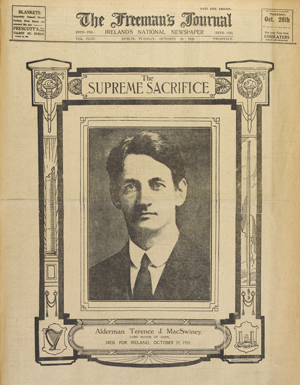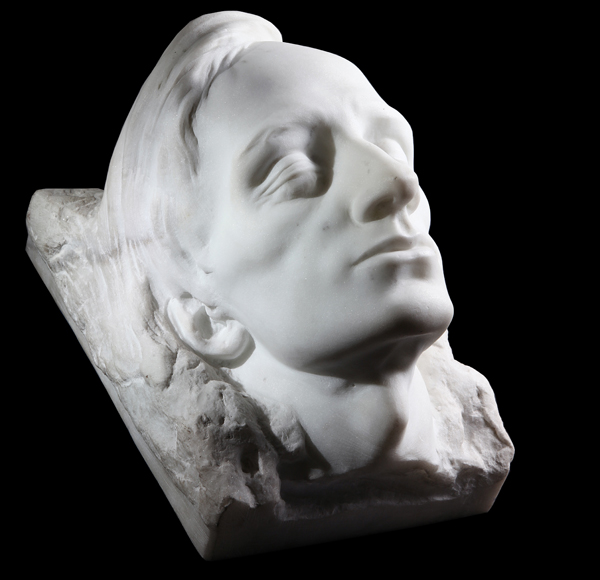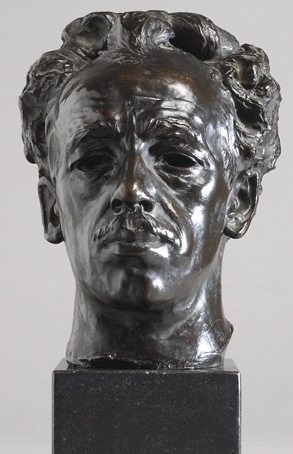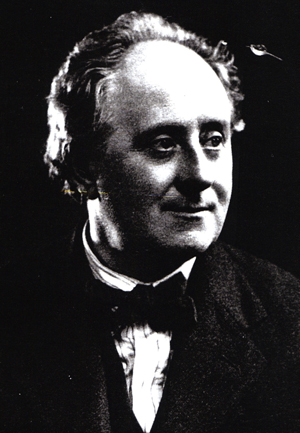‘An immortal smile of victory’
Published in Features, Issue 5 (September/October 2019), Volume 27Albert Power’s bust of Terence MacSwiney (1879–1920).
By Síghle Bhreathnach-Lynch
 On 26 October 1920 the Freeman’s Journal devoted its front page to the Sinn Féin lord mayor of Cork, Terence J. MacSwiney, who had died the previous day in Brixton Prison, London, after a hunger strike lasting 74 days. A photograph of the dead man, suitably adorned with well-known Celtic motifs, bore the legend ‘The Supreme Sacrifice’. Elected lord mayor of Cork in March 1920, MacSwiney was arrested in August by the British on charges of sedition and imprisoned in Brixton Prison. His death would bring him and the Irish struggle to international attention; there were demonstrations as far afield as Berlin and Buenos Aires.
On 26 October 1920 the Freeman’s Journal devoted its front page to the Sinn Féin lord mayor of Cork, Terence J. MacSwiney, who had died the previous day in Brixton Prison, London, after a hunger strike lasting 74 days. A photograph of the dead man, suitably adorned with well-known Celtic motifs, bore the legend ‘The Supreme Sacrifice’. Elected lord mayor of Cork in March 1920, MacSwiney was arrested in August by the British on charges of sedition and imprisoned in Brixton Prison. His death would bring him and the Irish struggle to international attention; there were demonstrations as far afield as Berlin and Buenos Aires.
Page six of the newspaper included a small photograph of a proposed memorial and a report that only a few days previously ‘the celebrated sculptor Albert Power’ had made a death-mask of MacSwiney in the prison. It also noted that the lord mayor of Dublin had been approached by writer and Sinn Féin activist Darrell Figgis, who suggested that a copy be cast in bronze and raised on O’Connell Bridge.
Albert Power
Already well known, Albert Power (1881–1945), the fine art sculptor, enjoyed critical acclaim at the annual exhibitions of the Royal Hibernian Academy for his portraits of distinguished men of letters: poet and novelist James Stephens (1913), writer of fantasy stories Lord Dunsany (1918), and poet and dramatist W.B. Yeats (1918). At the same time, as an artisan carver, he ran a monumental sculpture yard from his home in Geraldine Street, Dublin. He and his small firm were involved in the architectural restoration of the major banks on O’Connell Street after the Easter Rising. Meanwhile, his arresting statue representing Science dominated the pediment of the newly built College of Science (now Government Buildings). Also regularly produced were a variety of religious items for the interior decoration of the many Roman Catholic churches all over the country.
Among his closest friends was novelist, poet, athlete and surgeon Oliver St John Gogarty (1878–1957), who moved in the same Dublin literary and artistic circles as James Stephens, James Joyce, George Moore, W.B. Yeats and other luminaries of the Irish renaissance. Gogarty was responsible for Power’s entry into this eminent circle and it was he who had commissioned both the Dunsany and Yeats portraits. The surgeon was an enthusiastic supporter and patron of the young artist—so much so that he gave Power the use of an upstairs room over his garage in Ely Place, which the sculptor used both as an extra studio and as a place to store materials.

Above: Albert Power’s marble portrait of Terence MacSwiney, in the form of a death-mask. (Cork Public Museum)
Thanks to Gogarty’s patronage, in late 1920 the artist found himself involved in the first of a series of political commissions that would gain him a reputation as the foremost nationalist sculptor of Free State Ireland. It was the height of the War of Independence. As a Sinn Féiner, Gogarty participated in a variety of anti-Black-and-Tan schemes, allowing his home to be used as a safe house and his car for transporting disguised IRA Volunteers. Along with many others moved by the hunger striker, he perceived MacSwiney to be the embodiment of the contemporary hero: courageous and unswerving in his beliefs, and willing to sacrifice his life should it prove necessary. Not surprisingly in view of his keenness to have his literary friends immortalised in sculpture, Gogarty arranged to have MacSwiney remembered in a similar manner and engaged Power in the production of a very unusual portrait.
Smuggled into Brixton Prison

Above: Albert Power’s bronze portrait bust of James Stephens, c. 1912, one of his many portraits of distinguished Irish men of letters. (Private collection)
The plan was to smuggle Power into Brixton Prison in the guise of a relative in order to sketch the features of the dying man. This sketch would provide the basis for a portrait. Permission was secured for a family visit to the prison on 23 September, with Power and Gogarty posing as relatives. On arrival they were all thoroughly searched, but the sculptor managed to secrete a tiny ball of wax between his fingers and some tiny wooden picks in the pocket of his jacket. The officer thought that they were matchsticks and the sculptor was allowed through to the cell. Conscious of the prison guard watching him from the doorway, Power knelt down at the bedside. While supposedly in conversation with the prisoner, he deftly recorded his features in wax. This entailed shaping the wax to make a three-dimensional sketch by pinching it in places and using the picks for indentation. Later he would use photographs as a further aide-mémoire. The visit lasted about eight minutes, during which MacSwiney spoke of his journey from Cork and the fasting.
The portrait, unusually, took the form of a death-mask rather than a traditional head and shoulders. As the MacSwineys wished the dying man to be remembered as a Christian martyr, this format ensured that he would be remembered for the manner of his death, a death that was meaningful in the context of ongoing conflict in Ireland and one with religious connotations. MacSwiney had been a daily communicant during his lifetime and before his death had received a papal blessing. Rather than seeing his death as suicide, it was regarded by Irish nationalists as a tragedy caused by British oppression.
By the time of Power’s visit MacSwiney’s face would already have been showing the effects of the hunger strike, but the features were rendered as those of an ascetic, recalling Christian martyrs in traditional paintings and sculptures. MacSwiney’s expression suggested quiet triumph over adversity. A beatific smile hovered on his lips, and his almost closed eyes were in the tradition of Christ in a pietà. This arose out of words spoken by him to the artist: in talking about the hunger strike, MacSwiney whispered, ‘’Twas good, ’twas good’. The sketch fashioned by Power captured what was later remembered as ‘an immortal smile of victory’. The quality of the carving was superb, with areas of the block left unworked to create a natural base from which the features emerged.
Feared reprisals

Above: Sculptor Albert Power, c. 1933. By then he had a reputation as the foremost nationalist sculptor of Free State Ireland. (Private collection)
Yet Power had reason to be concerned about the commission. The Freeman’s Journal published a photograph of the original plaster and reported on the visit to Brixton Prison. This drew undesirable public attention to the sculptor, and he was afraid that the authorities, in particular the Black and Tans, would come to his studio and destroy the surreptitiously sketched portrait. As a result, friends were given extra plaster copies to conceal and the original marble was hidden in the Four Courts office of barrister C.P. Curran, another patron and close friend of Power. The sculptor swore an affidavit to the effect that the marble was the one and only original portrait. When it was considered safe to do so, it was smuggled to the MacSwiney family in Cork, hidden in a box destined for the butter and margarine manufacturers O’Dowdall and O’Mahony.
Power held political views similar to Gogarty’s. As an artist, the motivation for much of his work throughout his career sprang from deeply held nationalist sentiments. These had flourished during his time as a student and assistant teacher at the Dublin Metropolitan School of Art (1891–1911). He was a close friend of sculpture student Willie Pearse and, like others at the school, including Seán Keating, Grace Gifford and Countess Markievicz, he strongly favoured an independent Ireland. During the Easter Rising he had gone to the GPO to offer support, but Patrick Pearse told him to go home to his family since he would be needed to produce a distinctive Irish art after independence. And, indeed, Power’s many future political portraits and monuments were underscored by a personal artistic dialogue with Irish nationalism and its role as a signifier of identity in the first half of the twentieth century.
Síghle Bhreathnach-Lynch is an art historian and former Curator of Irish Art at the National Gallery of Ireland.
FURTHER READING
S. Bhreathnach-Lynch, Ireland’s art, Ireland’s history, 1845 to present (Omaha, 2007).
A. Dolan, Commemorating the Irish Civil War (Cambridge, 2003).
J. Sheehy, The rediscovery of Ireland’s past: the Celtic Revival 1830–1930 (London, 1980).
















